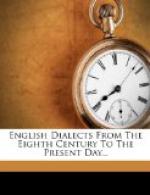Now ought we to praise the warden of heaven’s realm, the Creator’s might and His mind’s thought, the works of the Father of glory; (even) as He, of every wonder, (being) eternal Ruler, established the beginning. He first (of all) shaped, for the sons of men, heaven as (their) roof, (He) the holy Creator. The middle world (He), mankind’s warden, eternal Ruler, afterwards prepared, the world for men—(being the) Almighty Lord.
The locality of these lines is easily settled, as we may assign them to Whitby. Similarly, Beda’s Death-song may be assigned to the county of Durham.
A third poem, extending to fourteen lines, may be called the “Northumbrian Riddle.” It is called by Dr Sweet the “Leiden Riddle,” because the MS. that contains it is now at Leyden, in Holland. The locality is unknown, but we may assign it to Yorkshire or Durham without going far wrong. There is another copy in a Southern dialect. These three brief poems, viz. Beda’s Death-song, C{ae}dmon’s Hymn, and the Riddle, are all printed, accessibly, in Sweet’s Anglo-Saxon Reader.
There is another relic of Old Northumbrian, apparently belonging to the middle of the eighth century, which is too remarkable to be passed over. I refer to the famous Ruthwell cross, situate not far to the west of Annan, near the southern coast of Dumfriesshire, and near the English border. On each of its four faces it bears inscriptions; on two opposite faces in Latin, and on the other two in runic characters. Each of the latter pair contains a few lines of Northern poetry, selected from a poem (doubtless by the poet Cynewulf) which is preserved in full in a much later Southern (or Wessex) copy in a MS. at Vercelli in Piedmont (Italy). On the side which Professor Stephens calls the front of the cross, the runic inscriptions give us two quotations, both imperfect at the end; and the same is true of the opposite side or back. The MS. helps us to restore letters that are missing or broken, and in this way we can be tolerably sure of the correct readings.
The two quotations in front are as follows: it will be seen that the cross itself is supposed to be the speaker.
1. [on]gered{ae} hin{ae} god almechttig
tha he walde on galgu gistiga,
modig fore all{ae} men; buga [ic
ni darst{ae}.]
2. [ahof] ic riicn{ae} kyningc,
heafun{ae}s hlafard; h{ae}lda ic
ni darst{ae}.
bism{ae}radu ungket men ba {ae}t-gadre.
ic w{ae}s mith blod{ae} bistemid
bigoten of [his sidan.]
The two quotations at the back are these:
3. Crist w{ae}s on rodi;
hwethr{ae} ther fus{ae} fearran
cwomu
{ae}ththil{ae} til anum; ic th{ae}t
al biheald.
sare ic w{ae}s mith sorgum gidr{oe}fid;
hnag [ic hwethr{ae} tham secgum
til handa.]
4. mith strelum giwundad
alegdun hi{ae} hin{ae} limw{oe}rign{ae};
gistoddum him {ae}t his lic{ae}s
heafdum,
bihealdun hi{ae} ther heafun[{ae}s
hlafard.]




